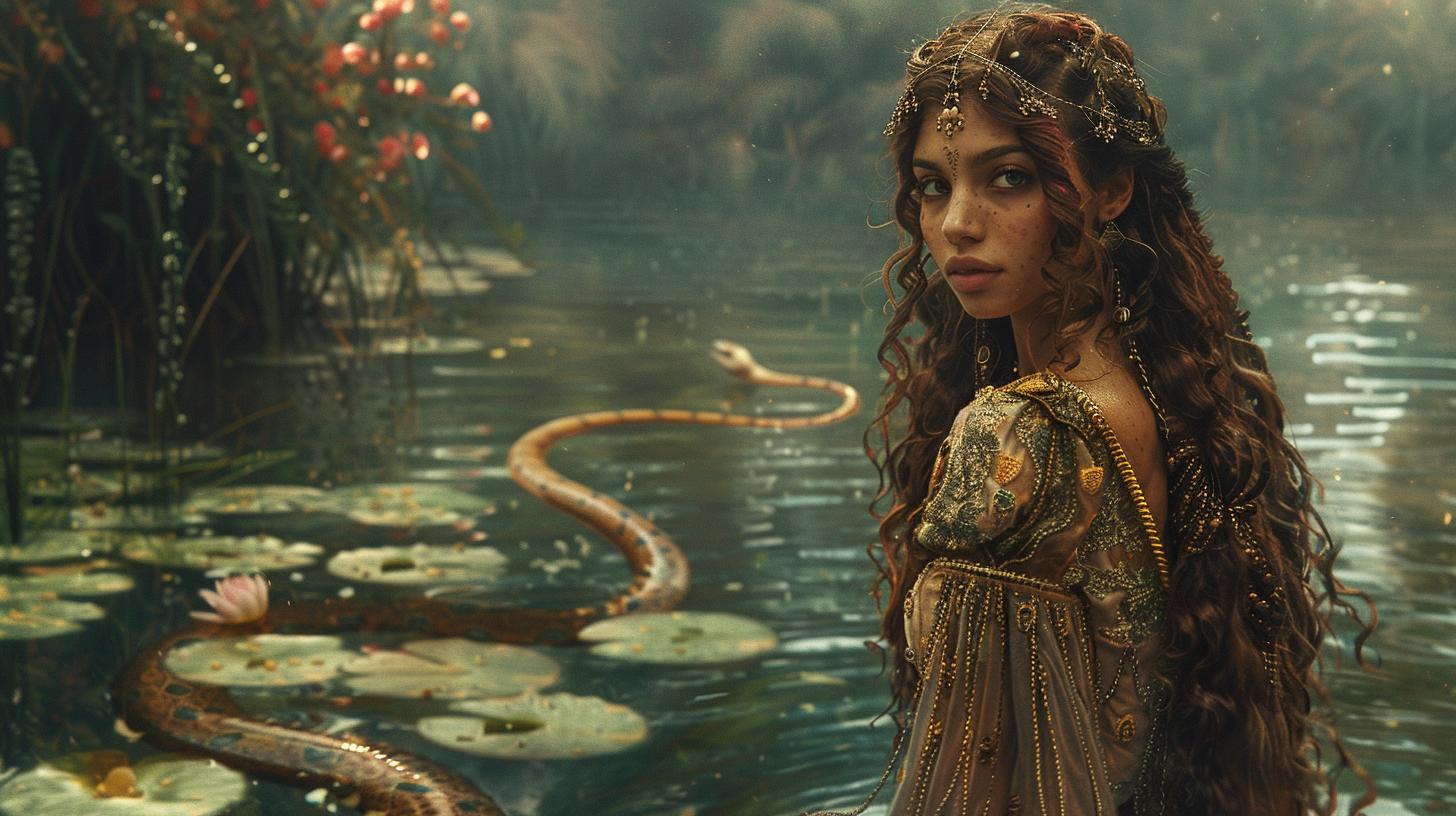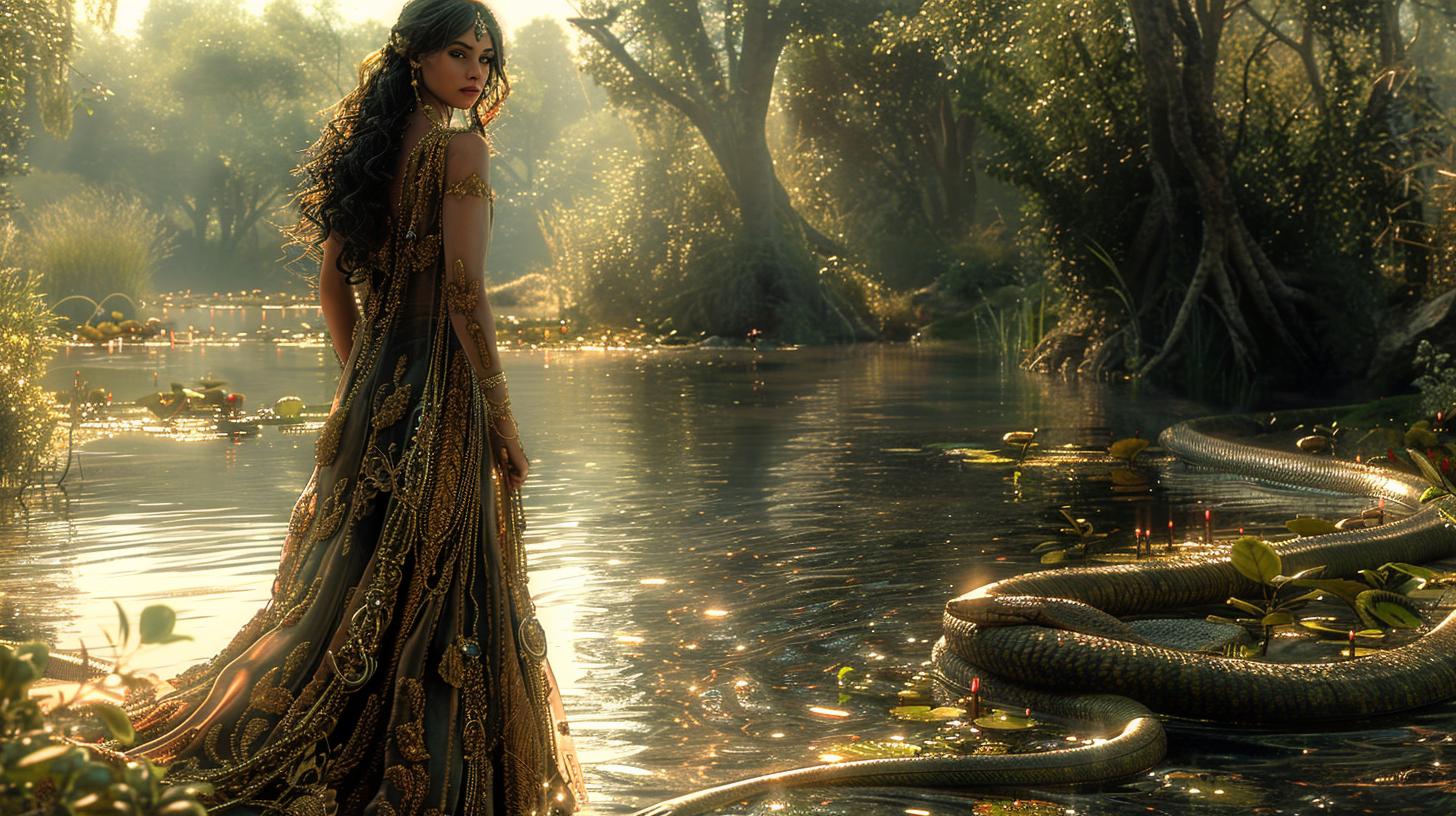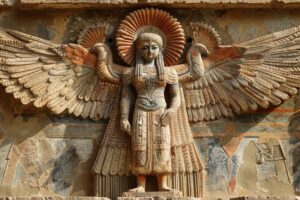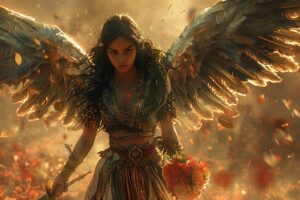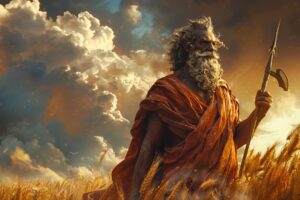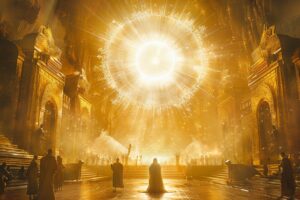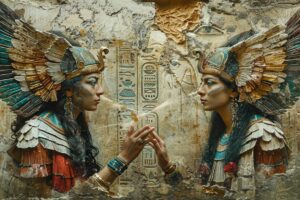Ishara Goddess: Origin, Expansion, and Legacy

Ishara, an ancient goddess, was first worshipped in the city of Ebla in northern Syria around the third millennium B.C. She played a significant role as the tutelary deity of the royal family and was also associated with other important deities of Ebla.
Her worship spread throughout the Near East, including cities like Alalakh, Ugarit, and Mari. Over time, she was adopted by the Hurrians and later incorporated into the Hittite pantheon, showing her broad cultural influence.
Origin and Early Appearances
Ishara’s ancient origins trace back to the third millennium B.C., where she played a significant role in various religious practices.
The Ancient City of Ebla
The Tutelary Goddess of Ebla
Ishara was primarily venerated in the ancient city of Ebla, located in what is now northern Syria. She was regarded as the tutelary goddess of the Eblaite royal family, signifying her high status and importance.
Numerous texts from Ebla indicate that Ishara held a prominent position in the pantheon, often receiving sacrifices and offerings in temples dedicated to her.
Association with Other Eblaite Deities
In Ebla, Ishara was frequently associated with other important deities, such as Resheph, the god of plague and war. This association highlights her multifaceted nature, intertwining her roles with themes of both protection and conflict.
The synergy between Ishara and Resheph in religious practices and temple activities underscores the collaborative dynamics within the Eblaite pantheon.
Religious Texts and Evidence
The worship of Ishara in Ebla is well-documented in numerous religious texts. These texts provide valuable insights into the rituals, prayers, and hymns dedicated to her. Archaeological findings, including inscribed tablets, detail her invocation in ceremonies aimed at seeking her favor and protection.
This extensive textual evidence underscores the integral role she played in the spiritual life of Ebla’s inhabitants.
The Role of Ishara in Ebla
Ishara’s role in Ebla extended beyond the confines of royal worship. She was seen as a protector of the city and its people. Her influence permeated various aspects of daily life, from legal matters to social gatherings.
Ishara’s divine patronage was believed to ensure the prosperity and stability of Ebla, fostering a sense of communal identity and religious cohesion among its citizens.
Geographic and Cultural Expansion
The worship of Ishara extended from her origins in Ebla throughout the Near East, showcasing her growing cultural influence and significance.
Spread Across the Near East
Influence in Alalakh and Ugarit
Ishara’s cult spread to Alalakh and Ugarit, where she became a prominent deity. In Alalakh, she was revered in local temples, and texts from the region highlight her importance. Ugaritic texts also document her worship, demonstrating her integration into the city’s religious practices.
Presence in Mari and Mesopotamia
In Mari, Ishara was venerated alongside other major deities. Her presence in royal and religious texts from Mari indicates her significant role in the region’s spiritual life. In Mesopotamia, Ishara became associated with well-known deities like Ishtar, and her worship persisted through various dynastic periods.
Adoption by the Hurrians
The Hurrians adopted Ishara as part of their pantheon, reflecting their rich religious syncretism. She was associated with Allani, the queen of the dead, and was invoked in rituals related to oath-taking and divination.
Hurrian texts from Ugarit and other sites indicate her widespread cultic significance.
Incorporation into the Hittite Pantheon
Ishara’s integration into the Hittite pantheon further exemplifies her cultural expansion. The Hittite adoption of her worship came from her prominence in Syria and Kizzuwatna. Textual evidence from the Hittite empire documents specific rituals dedicated to Ishara, underscoring her enduring importance.
Iconography and Symbolism
Ishara’s iconography and symbolism evolved over time, reflecting diverse aspects of her identity and worship in various cultures.
Visual Representations
Early Depictions
Early depictions of Ishara are largely lost or not clearly identified in surviving artifacts. There are, however, references suggesting she may have been portrayed with certain martial attributes, reflecting some of her associated characteristics.
The Scorpion as Symbol
One of the more enduring symbols of Ishara is the scorpion. This association emerged later in her worship history, perhaps replacing another animal, the bashmu, which was a kind of dragon.
The scorpion symbol is particularly interesting given its dual connotations of danger and protection, fitting for a deity with complex attributes.
Association with Weapons
Ishara’s iconography might involve weapons, indicating a connection to martial prowess and possibly to aspects of protection and aggression. This association is less documented in visual artifacts but noted in textual references and symbolic representations.
Symbolic Associations
Beauty and Femininity
Despite her fearsome aspects, Ishara is also strongly associated with beauty and femininity. Descriptions of her often highlight fine garments and ornate jewelry, symbolizing not just physical attractiveness but also the allure and mystique associated with divine femininity.
The Star of the Scorpion
Ishara’s association extends to celestial symbols, most notably the “Star of the Scorpion.” In Babylonian astronomy, this specific star symbolizes her connection to cosmic and divine elements, reinforcing her multifaceted nature within ancient mythologies.
Attributes and Roles
Ishara’s attributes and roles reflect her multifaceted nature in ancient religious contexts, encompassing domains such as creativity, fertility, health, and the sanctity of oaths.
Creativity and Passion
Ishara was inherently associated with creativity and passion. She was revered for her influence over artistic endeavors and romantic relationships. The intensity of passion she inspired extended beyond mere romantic love, infusing various aspects of cultural and personal creativity.
Ishara’s domain of passion was also reflected in rituals that involved music, dance, and artistic expression, underscoring the creative energy she embodied.
Fertility and Abundance
Ishara’s role as a goddess of fertility and abundance was crucial in ancient agrarian societies. She was believed to bestow fertility on the land, ensuring bountiful harvests and the prosperity of livestock.
Her influence extended to human fertility, with couples invoking her favor to bless them with children. This aspect of her deity was deeply integrated into seasonal festivals and agricultural rites, symbolizing the cyclical nature of life and growth.
Healing and Health
Ishara was also seen as a goddess of healing and health. In this role, she was invoked to alleviate suffering and promote overall well-being. Her curative powers were sought in times of illness, and she was believed to possess the ability to cure various ailments.
Temples and rituals dedicated to Ishara often included practices aimed at securing her blessings for physical and spiritual healing, highlighting the holistic nature of health in her worship.
Guardian of Oaths and Divination
Ishara’s guardianship over oaths and divination underscored her role in maintaining social and moral order.
She was called upon to witness and sanctify vows, ensuring their adherence. Betraying an oath sworn in her name was considered a grave offense, invoking her wrath. Additionally, her role extended to divination, where she was believed to aid in revealing hidden truths and guiding decisions.
Ritualistic practices involving oaths and divination often sought her vigilance and wisdom, reinforcing her pivotal role in these sacred domains.
Connections with Other Deities
Ishara’s worship connections span across various deities in different pantheons, reflecting her integration and influence in the religious and cultural landscapes of Mesopotamia, Hurrian, and Hittite traditions.
Mesopotamian Pantheon
Relationship with Ishtar
Ishara shares several characteristics with Ishtar, the well-known goddess of love and war. Although not considered identical, their overlapping domains suggest a close relationship. Both goddesses were invoked for matters related to passion, fertility, and protection.
In certain texts, Ishara and Ishtar appear jointly, reinforcing their collective impact on Mesopotamian religious practices. The comparison with Ishtar amplified Ishara’s role in rituals and cultural narratives.
Association with Dagan and Ninkarrak
During the Ur III period, Ishara was also associated with Dagan, a major deity of fertility and grain. This connection highlights her influence over agricultural prosperity and sustenance of societies.
Additionally, Ishara had ties with Ninkarrak, the healing goddess. This relationship emphasizes Ishara’s aspect as a deity of health and well-being, demonstrating her multifaceted role in the Mesopotamian pantheon.
Hurrian and Hittite Relationships
Link with Allani
In the Hurrian tradition, Ishara was connected with Allani, the queen of the underworld. This association underscores Ishara’s role in the domain of the dead, linking her to themes of mortality and afterlife.
Their relationship illustrated the intricate Hurrian beliefs about death and the divine hierarchy that governed the afterlife, with Ishara serving as a key figure in such narratives.
Role in the Hurrian Pantheon
- Adoption and Worship: Ishara was widely worshipped in Hurrian cities like Alalakh and Kizzuwatna, indicating her significant presence in the regional religious practices.
- Integration into Hittite Traditions: With the expansion of the Hittite Empire, Ishara was incorporated into the Hittite pantheon, further illustrating her adaptability and enduring reverence.
Hittite texts from Ugarit and other regions frequently mention Ishara, reflecting her integration into their religious fabric.
Ishara’s interactions with Hurrian and Hittite deities underscore her prominent standing and the syncretic nature of ancient Near Eastern religions, where deities often transcended cultural and regional boundaries.
Worship and Rituals
The worship of Ishara involved a variety of rituals and practices that evolved over time. This section explores the early and later practices associated with her veneration.
Early Practices
Offerings and Temples
In the early periods, worshippers made offerings to Ishara in dedicated temples. These offerings included food, drink, and other valuables, meant to honor the goddess and seek her favor. Temples served as central locations for these practices, where priests performed rituals and ceremonies.
Inclusion in Prayers and Songs
Ishara’s name frequently appeared in prayers and songs, reflecting her significance in religious and daily life. These texts often invoked her blessings for various aspects such as love, fertility, and health.
Chanting or singing these prayers was a common practice to reinforce her presence and power.
Development Over Time
Periods of Ur III and Babylon
During the periods of Ur III and Babylon, the worship of Ishara saw continuity and adaptation. Rulers and nobles maintained her temples and included her in state rituals. Her name was invoked in official prayers, and she was offered sacrifices to ensure the prosperity and protection of the realm.
Continuation into the First Millennium
The veneration of Ishara persisted into the first millennium B.C. Her worship continued in cities like Babylon and Uruk, signifying her enduring influence. Temples dedicated to her still received offerings, and her name remained prominent in religious texts and personal prayers.
Myths and Legends
The myths and legends surrounding Ishara provide a deep insight into her attributes and cultural impact. Various narratives from Mesopotamian and Hurrian traditions highlight her significance.
Mesopotamian Narratives
Gilgamesh and Atrahasis
In Mesopotamian literature, Ishara is mentioned in the context of major epics such as Gilgamesh and Atrahasis. Known primarily as a goddess of marriage, she played a role in uniting couples and overseeing matrimonial unions.
Ishara’s influence extends to the relationship dynamics in these stories, emphasizing her role in human connections and interactions.
In the Epic of Gilgamesh, Ishara is invoked during marriage ceremonies, symbolizing the binding power of vows.
Similarly, in the Atrahasis epic, her presence underscores the divine aspect of human agreements and partnerships, reinforcing the sacredness attributed to oaths.
Hurrian Texts
The Song of Liberation
Hurrian texts also depict Ishara in crucial roles. The ‘Song of Liberation’ narrates her efforts to save the city of Ebla from destruction. She is portrayed as a protector and a compassionate deity.
This myth emphasizes her deep connection with the city and its inhabitants, showcasing her as a figure of salvation and hope.
This narrative highlights Ishara’s protective nature and her ability to intervene in times of crisis.
She is shown as rallying other deities to aid in her cause, reflecting her significant status among the gods and her influential presence in mythological traditions.
The Song of Kumarbi
In the ‘Song of Kumarbi,’ Ishara is included among the deities called upon by the narrator. Her role in this myth involves listening to and validating the narrative being recounted.
This underscores her importance in Hurrian religious practices, where she is revered not only for her divine powers but also for her capacity as a witness to sacred stories and truths.
Her presence in the ‘Song of Kumarbi’ further establishes her as a key figure in the pantheon, one who is integral to the storytelling and myth-making processes in Hurrian culture. This aspect of Ishara’s character as a witness and validator of myths illustrates her encompassing influence in various domains of ancient life.
Influence and Legacy
Ishara’s impact has endured throughout different civilizations and eras, showcasing adaptability and cultural integration.
Persistence in Personal Names
Ishara’s name persisted in personal names across various regions and time periods. In cities like Mari, Tuttul, Terqa, and Ekalte, theophoric names incorporating Ishara’s name were common, indicating her widespread veneration.
These names often symbolized attributes revered by the people, emphasizing her influence in both personal and societal contexts. Such continuance in nomenclature highlights her importance in daily life and religious practices.
Adaptation Across Cultures
Influence in Ugaritic Texts
In Ugaritic texts, Ishara’s significance is evident. She was integrated into the religious framework of Ugarit, demonstrating her adaptability and the fluid nature of ancient Near Eastern religions.
Ugaritic rituals and myths featuring Ishara show her versatile roles, from being a goddess of love and fertility to one associated with divination and oaths. This multifaceted presence underscores her importance beyond a single cultural context.
Integration into Hittite Tradition
Ishara’s integration into the Hittite pantheon displays her extensive reach and the syncretic nature of ancient religions. The Hittites, known for incorporating deities from different regions, viewed Ishara as a significant figure, often linked with other major deities in their religious texts.
Hittite rituals and hymns reflect her roles in their mythos, spanning themes of love, healing, and guardianship of oaths. This incorporation highlights communal and religious exchanges between different civilizations during that era.

